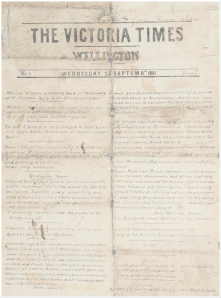Publication History:
Place of Publication: Buffalo Springs, NC, with occasional references to Fayetteville, NC.
Frequency: Published monthly
Volume and Issue Data: According to Smith, 12 numbers (8 issues surviving); vol. I, No. 9, Sept. 1858. pp. 227-248.
Size and Format: About 9- by 11-inches
Editor/Publisher: John McLean Harrington
Title Changes and Continuation: None
General Description and Notes:
According to Smith, The Young American contained limited traditional newspaper content but it was more of a literary publication. The paper included politics, poetry, short stories, anecdotes and other timeless items. See below.
Information Sources:
Bibliography: Michael Ray Smith, A Free Press in Freehand (Grand Rapids, MI: Edenridge Press, 2011). Additional bibliographic information about this and other Harrington papers contained in Smith.
Locations: John McLean Harrington Papers, Rare Book, Manuscript, and Special Collections Library, Perkins Library, Duke University, Durham, NC
Here’s an example of his table of contents.
No. 1 Vol. 1
Contents
January 1858
Title Page_ _ _ _ _ _ _ _ _ _ _ _ _ _ _ _ _ _ _ _ _ _ _ _ _ _ _ _ _ _ _ _ _ _ _ _ _1
An incident of the French Revo
Lution, Founded on Fact_ _ _ _ _ _ _ _ _ _ _ _ _ _ _ _ _ _ _ _ _ _ _ _ _ _ _ _2
Odds and ends_ _ _ _ _ _ _ _ _ _ _ _ _ _ _ _ _ _ _ _ _ _ _ _ _ _ _ _ _ _ _ _ _ 12
Foreign News_ _ _ _ _ _ _ _ _ _ _ _ _ _ _ _ _ _ _ _ _ _ _ _ _ _ _ _ _ _ _ _ _ _ 13
Ourselves _ _ _ Editorial_ _ _ _ _ _ _ _ _ _ _ _ _ _ _ _ _ _ _ _ _ _ _ _ _ _ _ _ 14
North Carolina_ _ _ _ _ _ _ _ _ _ _ _ _ _ _ _ _ _ _ _ _ _ _ _ _ _ _ _ _ _ _ _ _ 15
Editorial_ _ _ _ _ _ _ _ _ _ _ _ _ _ _ _ _ _ _ _ _ _ _ _ _ _ _ _ _ _ _ _ _ _ _ _ _16
Reader_ _ _ _ _ _ _ _ _ _ _ __ _ _ _ _ _ _ _ _ _ _ _ _ _ _ _ _ _ _ _ _ _ _ _ _ _16
The Leviathan_ _ _ _ _ _ _ _ _ _ _ _ _ _ _ _ _ _ _ _ _ _ _ _ _ _ _ _ _ _ _ _ _ 17
Death of an Editor_ _ _ _ _ _ _ __ _ _ _ _ _ _ _ _ _ _ _ _ _ _ _ _ _ _ _ _ _ _ 18
How Long_ _ _ _ _ _ _ _ _ __ _ _ _ _ _ _ _ _ _ _ _ _ _ _ _ _ _ _ _ _ _ _ _ _ _18
Oh! Sing again (Poetry)_ _ _ _ _ _ _ _ _ _ _ _ _ _ _ _ _ _ _ _ _ _ _ _ _ _ _ _19
Littles on Nothings_ _ _ _ _ _ _ _ _ _ _ _ _ _ _ _ _ _ _ _ _ _ _ _ _ _ _ _ _ _ 20
Epigram_ _ _ _ _ _ _ _ _ _ _ _ _ _ _ _ _ _ _ _ _ _ _ _ _ _ _ _ _ _ _ _ _ _ _ _ 20
Spittin on the Floor (Poetry)_ _ _ _ _ _ _ _ _ _ _ _ _ _ _ _ _ _ _ _ _ _ _ _ 21
Thanatos_ _ _ _ _ _ _ _ _ _ _ _ _ _ _ _ _ _ _ _ _ _ _ _ (Poetry) _ _ _ _ _ _ 22
Humorous_ _ _ _ _ _ _ _ _ _ _ _ _ _ _ _ _ _ _ _ _ _ _ _ _ _ _ _ _ _ _ _ _ _ _23
Hard Times_ _ _ (Poetry)_ _ _ _ _ _ __ _ _ _ _ _ _ _ _ _ _ _ _ _ _ _ _ _ _ _24
Riddle_ _ _ _ _ _ _ _ _ _ _ _ _ _ _ _ _ _ _ _ _ _ _ _ _ _ _ _ _ _ _ _ _ _ _ _ _ 25
Literary Notices_ _ _ _ _ _ _ _ _ _ _ _ _ _ _ _ _ _ __ _ _ _ _ _ _ _ _ _ _ _ 26
Advertisements_ _ _ _ _ _ _ _ _ _ _ _ _ _ _ _ _ _ _ _ _ _ _ _ _ _ _ _ _ _ _ 27







You must be logged in to post a comment.